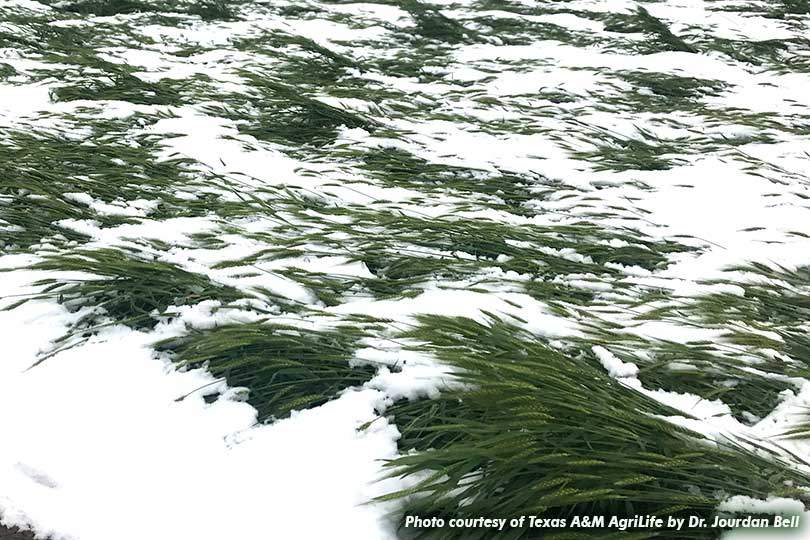By Shala Watson
Multimedia Writer
Texas is no stranger to unpredictable weather patterns and the end of April brought a cold front that dropped late season snowfall in some regions of the Panhandle.
While it’s still too early to measure yield losses, Texas A&M AgriLife Extension Service specialists were out scouting wheat fields for damage.
“There was wheat damaged in Texas,” Dr. Clark Neely, Texas A&M AgriLife Small Grains and Oilseed Extension specialist, said. “I don’t think that the damage is going to be nearly as severe as what we’re hearing coming out of Kansas though.”
Early reports show the Texas wheat crop escaped major losses. Other states like Kansas and Oklahoma weren’t as fortunate as the heaviest snowfall was concentrated in the far western portion of Kansas.
“It definitely sounds to me like the majority of the fields, if they were laid over by the wind and snow, have stood up by now,” Neely said.
There was a wide range of wheat crop maturity. Neely said the crop as a whole was “growing nearly two weeks ahead of schedule.”
Some varieties of wheat were close to three weeks from harvest and some varieties were more than a month away from harvest when the snow hit the Panhandle.
Neely said the wheat crop in the Panhandle was anywhere from the pre-boot phase all the way up through the dough stage.
Neely heard reports that poor thinner-looking wheat didn’t lay over quite as bad compared to some of the irrigated wheat acreage that was further ahead.
There were some cases, though, where the stem was broken or crimped over. Neely said that may not kill the wheat outright, but it will likely have an impact on the crop.
“It will probably reduce the flow of water and nutrients up to the head so it might reduce yield or quality,” Neely said.
Texas had the lowest planted wheat acreage in over a century this growing season after a global surplus in wheat supplies has continued to push prices down.
But the bad weather actually gave wheat prices a small boost, according to Neely.
“We actually did see a price jump,” Neely said. “I don’t know that this made a big difference in the long term for producers, but it did give them a pricing opportunity and hopefully they can lock in a higher price for their wheat, but prices overall are still low.”
He said the damage will have a minimal effect on global prices and production.
“I don’t know that this is going to affect the future of wheat production or prices to a large extent moving forward,” Neely said.
Most global production trends don’t indicate that wheat stocks will drop much in the foreseeable future.
“There is some indication we might see a tightening of supply in high quality wheat, which is mostly what Texas and the U.S. produces. So that might be good for us,” Neely said.

